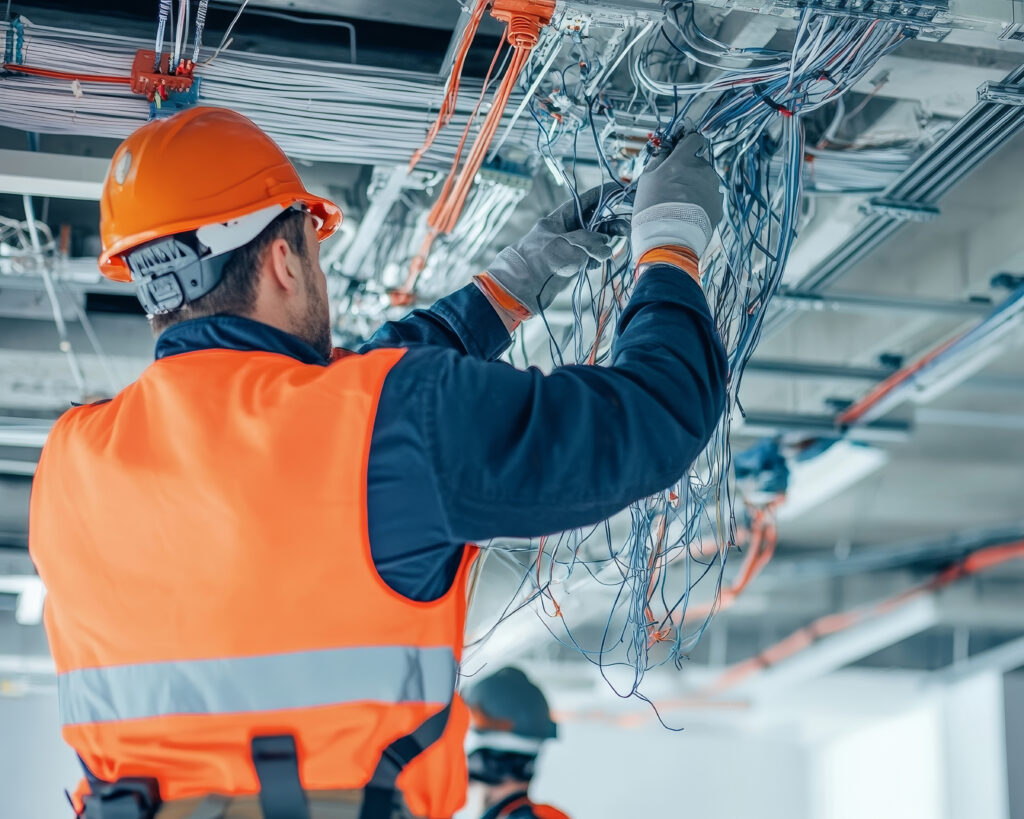Electricity powers our work and lives, but without proper precautions, it can quickly turn deadly. Whether you’re an electrician or work in an office, understanding electrical safety can save lives. Let’s explore key practices for staying safe while working with electricity.
Electricity might shock you, but this knowledge won’t.
Electricity flows in predictable ways, until something disrupts its path.
- Voltage, Current, and Resistance
- Voltage pushes electricity through a circuit (think of water pressure in a hose).
- Current is the flow of electricity.
- Resistance slows that flow, like friction in a hose.
- Conductors vs. Insulators
- Metals like copper allow electricity to flow easily, while rubber and dry wood resist it.
- Water can make insulators like wood conductive, which is why wet conditions increase risk.
- Grounding
- Grounding systems provide a safe path for electricity in case of a fault, directing it away from people.
Takeaway: Insulation, grounding, and understanding these basics reduce your risk of electrical mishaps.
Find hazards before they find you.
Identifying risks is the first step toward safety.
- Damaged Wires or Equipment
- Frayed cords and exposed wires can lead to shocks or fires.
- Wet Conditions
- Even small spills can create a conductive surface, turning an everyday task into a hazard.
- Overloaded Circuits
- Too many devices plugged into one outlet can overheat circuits, causing fires.
Quick Tips:
- Regularly inspect wires and cords for damage.
- Avoid using electrical equipment in wet areas.
- Distribute electrical loads across multiple circuits.
Play it smart, not shocking.
Simple steps can significantly lower the risk of electrical injuries.
Use Personal Protective Equipment (PPE):
-
- Gloves, hard hats, and insulated tools provide a physical barrier against shocks.
Install Ground Fault Circuit Interrupters (GFCIs):
-
- These devices detect irregular currents and shut off power before an injury occurs.
De-energize Equipment Before Maintenance:
-
- Use lockout or tagout procedures to ensure machinery stays off during repairs.
Remember: Safety starts before you plug in.
Be cool under pressure, not fried under wires.
Knowing how to respond can save a life.
Assess the Scene:
-
- Never touch someone who’s being shocked. Cut off the power first.
Separate the Victim Safely:
-
- Use a non-conductive object like a wooden broom to move them away from the source.
Call for Help:
-
- Contact emergency services immediately.
Administer CPR if Trained:
-
- If the victim isn’t breathing, act quickly while waiting for professionals.
Good habits spark great safety.
A clean, organized workspace reduces risks.
- Keep Cords and Wires Secure:
- Avoid tangles or exposed wiring.
- Maintain Equipment Regularly:
- Replace damaged tools and check connections frequently.
- Educate and Train Workers:
- Provide regular safety training and refreshers.
Pro Tip: Always use tools and equipment designed for the specific environment, especially in wet or dusty areas.
Make safety a team sport, not a solo act.
Workplace safety isn’t just about rules, it’s about fostering a shared mindset.
- Encourage Open Communication:
- Workers should feel comfortable reporting hazards.
- Provide Accessible Resources:
- Ensure PPE and safety tools are easy to access.
- Conduct Regular Audits:
- Identify and address risks before they lead to accidents.
Power up your knowledge before you power up your tools.
Electricity is essential but unforgiving. With proper precautions, training, and teamwork, we can reduce risks and focus on the task at hand. Remember, safety isn’t just about compliance, it’s about making sure everyone goes home safe every day.
Charge up your safety game today.
Electricity powers our lives, but safety must always come first. If you’re unsure about electrical hazards or need guidance on workplace protocols, now is the time to act. Speak with your supervisor or safety team to ensure compliance with OSHA standards and access the proper tools and PPE for your tasks. Together, we can create a culture of safety and vigilance that protects everyone. Electrical safety matters. Learn how to prevent hazards and protect lives with our Electrical Safety Training Course.
Want to level up even more? Check out our HAZWOPER Safety: Electrical Safety Training Course for advanced protocols in high-risk environments.
References



